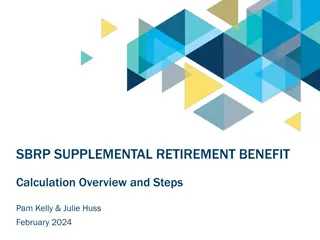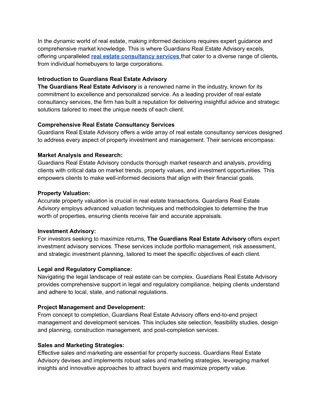
Investing in Real Estate and Retirement Planning Options
Explore ways to invest in real estate, understand the concept of capital gains, and learn about the advantages and disadvantages of real estate investing. Discover how retirement plans work, the tax implications, and how they can benefit your financial future.
Download Presentation

Please find below an Image/Link to download the presentation.
The content on the website is provided AS IS for your information and personal use only. It may not be sold, licensed, or shared on other websites without obtaining consent from the author. If you encounter any issues during the download, it is possible that the publisher has removed the file from their server.
You are allowed to download the files provided on this website for personal or commercial use, subject to the condition that they are used lawfully. All files are the property of their respective owners.
The content on the website is provided AS IS for your information and personal use only. It may not be sold, licensed, or shared on other websites without obtaining consent from the author.
E N D
Presentation Transcript
III. INVESTING B. Investing Options 4. Real Estate Property 5. Retirement Plans savings plan for retirement.
Ways to invest in real-estate? Buy a house, live in it, and sell it later at a profit. Buy income property (such as an apartment house or a commercial building) and rent it. Buy land and hold it until it rises in value.
$$ CAPITAL GAINS $$ capital gains: profits from the sale of a capital asset such as stocks, bonds, or real estate.
Real Estate Advantages Excellent protection against inflation. Disadvantages Can be difficult to convert into cash. A specialized type of investment requiring study and knowledge of business. teens lesson 12 - slide 12-L
Retirement Plans what they are and how they work Plans that help individuals set aside money to be used after they retire. Federal income tax not immediately due on money put into a retirement account, or on the interest it makes. Income tax paid when money is withdrawn. Penalty charges apply if money is withdrawn before retirement age, except under certain circumstances. Income after retirement is usually lower, so tax rate is lower. teens lesson 12 - slide 12-M
Taxes on $80,000 Salary $80,000 salary with no retirement account Federal Tax Rate $77,100 - $160,850 $15,698.75 plus 28% of the amount over 77,100 Federal Income Tax = $15,698.75 + ($80,000 77,100)*.28 Federal Income Tax = $15,698.75 + $812 Total Federal Income Tax Paid = $ 16,510
Taxes on $80,000 Salary $80,000 Salary with 10% in Retirement Account $80,000 - $8,000 = $72,000 28% - Federal Tax Rate $77,100 - $160,850 25% - Federal Tax Rate $31,850 - $77,100 $4,386.25 plus 25% of the amount over 31,850 Federal Income Tax = $4,386.25 + ($72,000 31,850)*.25 Federal Income Tax = $4,386.25 + $10,037.50 Total Federal Income Tax = $14,423.75
Example Salary - $80,000 & Retirement Account (10%) Salary Taxed Federal Income Tax Paid $80,000 $16,510 $72,000 $14. 423.75 Amount Saved In taxes $2,086.25
Types of Retirement Plans Individual Retirement Account (IRA) Allows a person to contribute up to $5,000 of pre-tax earnings per year. Contributions can be made in installments or in a lump sum. teens lesson 12 - slide 12-M
Types of Retirement Plans Roth IRA (also called the IRA Plus) While the $5,000 annual contribution to this plan is not tax-deductible, the earnings on the account are tax-free after five years. The funds from the Roth IRA may be withdrawn after age 59, if the account owner is disabled, or used for educational expenses, or for the purchase of a first home. teens lesson 12 - slide 12-M
Types of Retirement Plans 401(k) Allows a person to contribute to a savings plan from his or her pre-tax earnings, reducing the amount of tax that must be paid. Some employers match contributions up to a certain level. teens lesson 12 - slide 12-M
Types of Retirement Plans Keogh Plan Allows a self-employed person to set aside up to 15% of income (but not more than $35,000 per year). teens lesson 12 - slide 12-M
IRAs return on investment contributions made only between ages of 22 30 (9 years) $2,000 contributed each year Total investment of $18,000 At an interest rate of 9%, by age 65 will have $579,471 contributions made only between ages of 31 65 (35 years) $2,000 made contributed each year Total investment of $70,000 At an interest rate of 9%, by age 65 will have $470,249 teens lesson 12 - slide 12-N
instrument maturity risk yield minimum balance taxable? Certificate of Deposit 90 days or more None if insured Moderate Varies Yes Bonds Corporate 5 30 years Some Moderate $1,000 Yes Municipal 1 20 years Some Moderate $5,000 No federal, some states Stocks Immediate Low to high Low to high Varies Yes U.S. Treasury Bills 1 year or less None Moderate $10,000 Federal only Notes 1 10 years None $1,000 Federal only Bonds 10 30 years None $1,000 Federal only Mutual Funds Varies Low to high Moderate Varies Usually Retirement Funds When buyer is 60 years old Low Moderate Varies At maturity teens lesson 12 - slide 12-O
Truth in Savings Law The Truth in Savings Act (Federal Reserve Regulation DD) requires financial institutions to disclose the following information on savings account plans they offer: Fees on deposit accounts The interest rate Other terms and conditions The annual percent yield (APY), which is the percentage rate expressing the total amount of interest that would be received on a $100 deposit based on the annual rate and frequency of compounding for a 365-day period. teens lesson 12 - slide 12-G
Avoiding Investment Fraud Each year billions of dollars are lost to fraudulent investments. Some of the most common include: Illegal pyramids, insider trading, and unlicensed investment brokers High-risk penny stocks and fraudulent securities Fraudulent franchises and business opportunities Internet services, 900-numbers, and high-tech investments promising high profits and minimal risk Opportunities to invest in movie deals and other entertainment ventures with promises of guaranteed profits and failure to disclose risk teens lesson 12 - slide 12-P
Avoiding Investment Fraud To protect yourself from becoming a victim of investment fraud, take the following actions: Become informed about investments and industries before investing Talk with others who have made similar investments Obtain information from state and federal regulatory agencies Never buy over the phone without first investigating the situation Avoid investment opportunities promising large returns in a short amount of time that seem too good to be true they probably are. For additional information, contact the following websites: www.ftc.gov; www.fraud.org; www.sec.gov; www.nasaa.org teens lesson 12 - slide 12-P






















